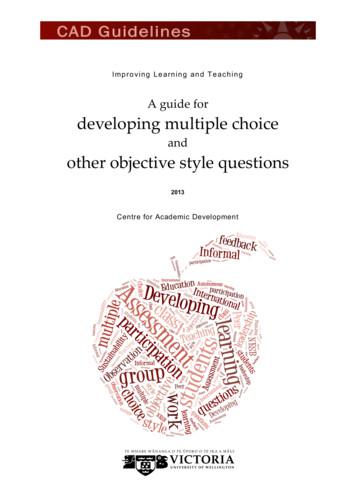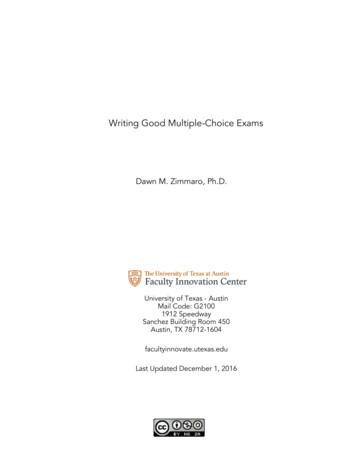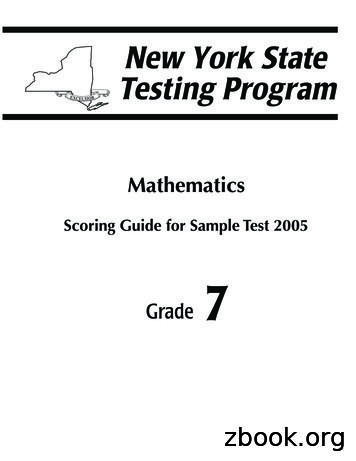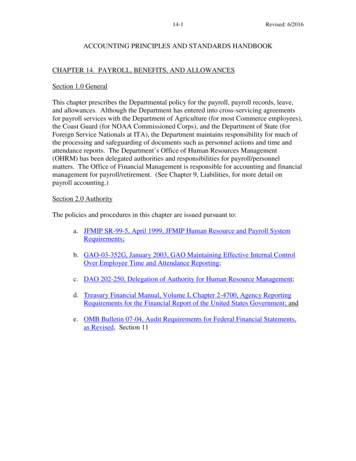MULTIPLE CHOICE QUESTIONSCHOICE QUESTIONS
MCQs from Ganong’s Review of Medical Physiology 24th EditionMULTIPLE CHOICE QUESTIONSFor all questions, select the single best answer unless otherwise directed.1. The membrane potential of a particular cell is at the K equilibrium. Theintracellular concentration for K is at 150 mmol/L and the extracellularconcentration for K is at 5.5 mmol/L. What is the resting potential?A. 70 mvB. 90 mvC. 70 mvD. 90 mv2. The difference in concentration of H in a solution of pH 2.0 compared with oneof pH 7.0 isA. 5-foldB. 1/5 as muchC. 105 foldD. 10 5 as much3. Transcription refers toA. the process where an mRNA is used as a template for protein production.B. the process where a DNA sequence is copied into RNA for the purpose of geneexpression.C. the process where DNA wraps around histones to form a nucleosome.D. the process of replication of DNA prior to cell division.4. The primary structure of a protein refers toA. the twist, folds, or twist and folds of the amino acid sequence into stabilized structureswithin the protein (ie, α-helices and β-sheets).B. the arrangement of subunits to form a functional structure.C. the amino acid sequence of the protein.D. the arrangement of twisted chains and folds within a protein into a stable structure.5. Fill in the blanks: Glycogen is a storage form of glucose.refers to the process of making glycogen and refersto the process of breakdown of glycogen.A. Glycogenolysis, glycogenesisB. Glycolysis, glycogenolysisC. Glycogenesis, glycogenolysisD. Glycogenolysis, glycolysis6.A.B.C.1The major lipoprotein source of the cholesterol used in cells ischylomicronsintermediate-density lipoproteins (IDLs)albumin-bound free fatty acids
MCQs from Ganong’s Review of Medical Physiology 24th EditionD. LDLE. HDL7. Which of the following produces the most high-energy phosphate compounds?A. aerobic metabolism of 1 mol of glucoseB. anaerobic metabolism of 1 mol of glucoseC. metabolism of 1 mol of galactoseD. metabolism of 1 mol of amino acidE. metabolism of 1 mol of long-chain fatty acid8. When LDL enters cells by receptor-mediated endocytosis, which of the followingdoes not occur?A. Decrease in the formation of cholesterol from mevalonic acid.B. Increase in the intracellular concentration of cholesteryl esters.C. Increase in the transfer of cholesterol from the cell to HDL.D. Decrease in the rate of synthesis of LDL receptors.E. Decrease in the cholesterol in endosomes.Chapter 21. The electrogenic Na, K ATPase plays a critical role in cellular physiology byA. using the energy in ATP to extrude 3 Na out of the cell in exchange for taking two K into the cell.B. using the energy in ATP to extrude 3 K out of the cell in exchange for taking two Na into the cell.C. using the energy in moving Na into the cell or K outside the cell to make ATP.D. using the energy in moving Na outside of the cell or K inside the cell to make ATP.2. Cell membranesA. contain relatively few protein molecules.B. contain many carbohydrate molecules.C. are freely permeable to electrolytes but not to proteins.D. have variable protein and lipid contents depending on their location in the cell.E. have a stable composition throughout the life of the cell.3. Second messengersA. are substances that interact with fi rst messengers outside cells.B. are substances that bind to fi rst messengers in the cell membrane.C. are hormones secreted by cells in response to stimulation by another hormone.D. mediate the intracellular responses to many diff erent hormones and neurotransmitters.E. are not formed in the brain.4.A.B.C.2Th eis anis anis anGolgi complexorganelle that participates in the breakdown of proteins and lipids.organelle that participates in posttranslational processing of proteins.organelle that participates in energy production.
MCQs from Ganong’s Review of Medical Physiology 24th EditionD. is an organelle that participates in transcription and translation.E. is a subcellular compartment that stores proteins fortraffi cking to the nucleus.5. EndocytosisA. includes phagocytosis and pinocytosis, but not clathrinmediated or caveolae-dependentuptake of extracellular contents.B. refers to the merging of an intracellular vesicle with the plasma membrane to deliverintracellular contents to the extracellular milieu.C. refers to the invagination of the plasma membrane to uptake extracellular contents intothe cell.D. refers to vesicular traffi cking between Golgi stacks.6. G protein-coupled receptorsA. are intracellular membrane proteins that help to regulate movement within the cell.B. are plasma membrane proteins that couple the extracellular binding of primary signalingmolecules to exocytosis.C. are plasma membrane proteins that couple the extracellular binding of primary signalingmolecules to the activation of heterotrimeric G proteins.D. are intracellular proteins that couple the binding of primary messenger molecules withtranscription.7. Gap junctions are intercellular connections thatA. p rimarily serve to keep cells separated and allow for transport across a tissue barrier.B. serve as a regulated cytoplasmic bridge for sharing of small molecules between cells.C. serve as a barrier to prevent protein movement within the cellular membrane.D. are cellular components for constitutive exocytosis that occurs between adjacent cells.8. F-actin is a component of the cellular cytoskeleton thatA. provides a structural component for cell movement.B. is defi ned as the “functional” form of actin in the cell.C. refers to the actin subunits that provide the molecular building blocks of the extendedactin molecules found in the cell.D. provide the molecular architecture for cell to cell communication.Chapter 31. In an experiment, a scientist treats a group of mice with an antiserum thatsubstantially depletes the number of circulating neutrophils. Compared withuntreated control animals, the mice with reduced numbers of neutrophils werefound to be significantly more susceptible to death induced by bacterialinoculation. The increased mortality can be ascribed to arelative deficit in which of the following?A. Acquired immunityB. OxidantsC. PlateletsD. Granulocyte/macrophage colony stimulating factor (GM-CSF)E. Integrins2. A 20-year-old college student comes to the student health center in Aprilcomplaining of runny nose and congestion, itchy eyes, and wheezing. She reportsthat similar symptoms have occurred at the same time each year, and that she3
MCQs from Ganong’s Review of Medical Physiology 24th Editionobtains some relief from over-the-counter antihistamine drugs, although theymake her too drowsy to study. Her symptoms can most likely be attributed toinappropriate synthesis of which of the following antibodies specifi c for treepollen?A. IgAB. IgDC. IgED. IgGE. IgM3. If a nasal biopsy were performed on the patient described in Question 2 whilesymptomatic, histologic examination of the tissue would most likely revealdegranulation of which of the following cell types?A. Dendritic cellsB. LymphocytesC. NeutrophilsD. MonocytesE. Mast cells4. A biotechnology company is working to design a new therapeutic strategy forcancer that involves triggering an enhanced immune response to cellular proteinsthat are mutated in the disease.Which of the following immune cells or processes will most likely not be requiredfor a successful therapy?A. Cytotoxic T cellsB. Antigen presentation in the context of MHC-IIC. Proteosomal degradationD. Gene rearrangements producing T cell receptorsE. The immune synapse5. The ability of the blood to phagocytose pathogens and mount a respiratoryburst is increased byA. interleukin-2 (IL-2)B. granulocyte colony-stimulating factor (G-CSF)C. erythropoietinD. interleukin-4 (IL-4)E. interleukin-5 (IL-5)6. Cells responsible for innate immunity are activated most commonly byA. glucocorticoidsB. pollenC. carbohydrate sequences in bacterial cell wallsD. eosinophilsE. thrombopoietin7. A patient suffering from an acute flare in his rheumatoid arthritis undergoes aprocedure where fluid is removed from his swollen and inflamed knee joint.Biochemical analysis of the inflammatory cells recovered from the removed fluidwould most likely reveal a decrease in which of the following proteins?A. Interleukin 1B. Tumor necrosis factor-αC. Nuclear factor-κBD. IκBα4
MCQs from Ganong’s Review of Medical Physiology 24th EditionE. von Willbrand factorChapter 41. Which of the following statements about glia is true?A. Microglia arise from macrophages outside of the nervous system and are physiologicallyand embryologically similar to other neural cell types.B. Glia do not undergo proliferation.C. Protoplasmic astrocytes produce substances that are tropic to neurons to help maintainthe appropriate concentration of ions and neurotransmitters by taking up K and theneurotransmitters glutamate and GABA.D. Oligodendrocytes and Schwann cells are involved in myelin formation around axons inthe peripheral and central nervous systems, respectively.E. Macroglia are scavenger cells that resemble tissue macrophages and remove debrisresulting from injury, infection, and disease.2. A 13-year-old girl was being seen by her physician because of experiencingfrequent episodes of red, painful, warm extremities. She was diagnosed withprimary erythromelalgia, which may be due to a peripheral nerve sodiumchannelopathy.Which part of a neuron has the highest concentration of Na channels per squaremicrometer of cell membrane?A. dendritesB. cell body near dendritesC. initial segmentD. axonal membrane under myelinE. none of Ranvier3. A 45-year-old female office worker had been experiencing tingling in her indexand middle fingers and thumb of her right hand. Recently, her wrist and hand hadbecome weak. Her physician ordered a nerve conduction test to evaluate her forcarpal tunnel syndrome. Which one of the following nerves has the slowestconduction velocity?A. Aα fi bersB. Aβ fi bersC. Aγ fi bersD. B fi bersE. C fi bers4. Which of the following is not correctly paired?A. Synaptic transmission: Antidromic conductionB. Molecular motors: Dynein and kinesinC. Fast axonal transport: 400 mm/dayD. Slow axonal transport: 0.5–10 mm/dayE. Nerve growth factor: Retrograde transport5
MCQs from Ganong’s Review of Medical Physiology 24th Edition5. A 32-year-old female received an injection of a local anesthetic for a toothextraction. Within 2 h, she noted palpitations, diaphoresis, and dizziness. Which ofthe following ionic changes is correctly matched with a component of the actionpotential?A. Opening of voltage-gated K channels: After hyperpolarizationB. A decrease in extracellular Ca 2 : RepolarizationC. Opening of voltage-gated Na channels: DepolarizationD. Rapid closure of voltage-gated Na channels: Resting membrane potentialE. Rapid closure of voltage-gated K channels: Relative refractory period6. A man falls into a deep sleep with one arm under his head. This arm isparalyzed when he awakens, but it tingles, and pain sensation in it is still intact.The reason for the loss of motor function without loss of pain sensation is that inthe nerves to his arm,A. fibers are more A. susceptible to hypoxia than B fibers.B. A fibers are more sensitive to pressure than C fibers.C. C fibers are more sensitive to pressure than A fibers.D. Motor nerves are more affected by sleep than sensory nerves.E. Sensory nerves are nearer the bone than motor nerves and hence are less affected bypressure.7. Which of the following statements about nerve growth factor is not true?A. It is made up of three polypeptide subunits.B. It is responsible for the growth and maintenance of adrenergic neurons in the basalforebrain and the striatum.C. It is necessary for the growth and development of the sympathetic nervous system.D. It is picked up by nerves from the organs they innervate.E. It can express both p75N TR and Trk A receptors.8. A 20-year old female student awakens one morning with severe pain and blurryvision in her left eye; the symptoms abate over several days. About 6 monthslater, on a morning after playing volleyball with friends, she notices weakness butnot pain in her right leg; the symptoms intensify while taking a hot shower.Which of the following is most likely to be the case?A. The two episodes described are not likely to be related.B. She may have primary-progressive multiple sclerosis.C. She may have relapsing-remitting multiple sclerosis.D. She may have a lumbar disk rupture.E. She may have Guillain–Barre syndrome.---------Chapter 56
MCQs from Ganong’s Review of Medical Physiology 24th Edition1. The action potential of skeletal muscleA. has a prolonged plateau phase.B. spreads inward to all parts of the muscle via the T tubules.C. causes the immediate uptake of Ca 2 into the lateral sacs of the sarcoplasmic reticulum.D. is longer than the action potential of cardiac muscle.E. is not essential for contraction.2. The functions of tropomyosin in skeletal muscle includeA. sliding on actin to produce shortening.B. releasing Ca2 aft er initiation of contraction.C. binding to myosin during contraction.D. acting as a “relaxing protein” at rest by covering up the sites where myosin binds toactin.E. generating ATP, which it passes to the contractile mechanism.3. The cross-bridges of the sarcomere in skeletal muscle are made up ofA. actin.B. myosin.C. troponin.D. tropomyosin.E. myelin.4. The contractile response in skeletal muscleA. starts after the action potential is over.B. does not last as long as the action potential.C. produces more tension when the muscle contracts isometrically than when the musclecontracts isotonically.D. produces more work when the muscle contracts isometrically than when the musclecontracts isotonically.E. decreases in magnitude with repeated stimulation.5. Gap junctionsA. are absent in cardiac muscle.B. are present but of little functional importance in cardiac muscle.C. are present and provide the pathway for rapid spread of excitation from one cardiacmuscle fiber to another.D. are absent in smooth muscle.E. connect the sarcotubular system to individual skeletal muscle cells.Chapter 61. Which of the following electrophysiological events is correctly paired with thechange in ionic currents causing the event?A. Fast inhibitory postsynaptic potentials (IPSPs) and closing of Cl channels.B. Fast excitatory postsynaptic potentials (EPSPs) and an increase in Ca 2 conductance.C. End plate potential and an increase in Na conductance.D. Presynaptic inhibition and closure of voltage-gated K channels.E. Slow EPSPs and an increase in K conductance.2. Which of the following physiological processes is not correctly paired with astructure?7
MCQs from Ganong’s Review of Medical Physiology 24th EditionA. Electrical transmission: gap junctionB. Negative feedback inhibition: Renshaw cellC. Synaptic vesicle docking and fusion: presynaptic nerve terminalD. End plate potential: muscarinic cholinergic receptorE. Action potential generation: initial segment3. Initiation of an action potential in skeletal muscleA. requires spatial facilitation.B. requires temporal facilitation.C. is inhibited by a high concentration of Ca 2 at the neuromuscular junction.D. requires the release of norepinephrine.E. requires the release of acetylcholine.4. A 35-year-old woman sees her physician to report muscle weakness in the extraoculareye muscles and muscles of the extremities. She states that she feels fine when she gets upin the morning, but the weakness begins soon after she becomes active. The weakness isimproved by rest. Sensation appears normal. The physician treats her with ananticholinesterase inhibitor, and she notes immediate return of muscle strength. Herphysician diagnoses her withA. Lambert–Eaton syndrome.B. myasthenia gravis.C. multiple sclerosis.D. Parkinson disease.E. muscular dystrophy.5. A 55-year-old female had an autonomic neuropathy which disrupted thesympathetic nerve supply to the papillary dilator muscle of her right eye. Whilehaving her eyes examined, the ophthalmologist placed phenylephrine in her eyes.The right eye became much more dilated than the left eye.This suggests thatA. the sympathetic nerve to the right eye had regenerated.B. the parasympathetic nerve supply to the right eye remained intact and compensated forthe loss of the sympathetic nerve.C. phenylephrine blocked the pupillary constrictor muscle of the right eye.D. denervation supersensitivity had developed.E. the left eye also had nerve damage and so was not responding as expected.6. A 47-year-old female was admitted to the hospital after reporting that she hadbeen experiencing nausea and vomiting for about two days and then developedsevere muscle weakness and neurological symptoms including ptosis anddysphagia.She indicated she had eaten at a restaurant the evening before the symptomsbegan. Lab tests were positive for Clostridium botulinum . Neurotoxins block thereuptake A. of neurotransmitters into presynaptic terminals.B. such as tetanus toxin bind reversibly to the presynaptic membrane at the neuromuscularjunction.C. reach the cell body of the motor neuron by diffusion into the spinal cord.D. exert all of their adverse effects by acting centrally rather than peripherally.E. such as botulinum toxin prevent the release of acetylcholine from motor neurons due tocleavage of either synaptosomeassociated proteins or vesicle associated membraneproteins.-----8
MCQs from Ganong’s Review of Medical Physiology 24th EditionChapter 71. Which of the following statements about neurotransmitters is true?A. All neurotransmitters are derived from amino acid precursors.B. Small molecule neurotransmitters include dopamine, histamine, ATP, glycine, enkephalin,and norepinephrine.C. Large molecule transmitters include ATP, cannabinoids, substance P, and vasopressin.D. Norepinephrine can act as a neurotransmitter in the periphery and a neuromodulator inthe CNS.E. Nitrous oxide is a neurotransmitter in the CNS.2. Which of the following statements is not true?A. Neuronal glutamate is synthesized in glia by the enzymatic conversion from glutamineand then diff uses into the neuronal terminal where it is sequestered into vesicles untilreleased by an infl ux of Ca 2 into the cytoplasm after an action potential reaches thenerveterminal.B. After release of serotonin into the synaptic cleft, its actions are terminated by reuptakeinto the presynaptic nerve terminal, an action that can be blocked by tricyclicantidepressants.C. Norepinephrine is the only small-molecule transmitterthat is synthesized in synapticvesicles instead of being transported into the vesicle after its synthesis.D. Each nicotinic cholinergic receptor is made up of five subunits that form a central channelwhich, when the receptor is activated, permits the passage of Na and other cations.E. GABA transaminase converts glutamate to GABA; the vesicular GABA transportertransports both GABA and glycine into synaptic vesicles.3. Which of the following receptors is correctly identified as an ionotropic or a Gprotein-coupled receptor (GPCR)?A. Neurokinin receptor: ionotropicB. Nicotinic receptor: GPCRC. GABA A receptor: ionotropicD. NMDA receptor: GPCRE. Glycine: GPCR4. A 27-year-old male was brought to the emergency room and presented withsymptoms of opioid intoxication.He was given an intravenous dose of naloxone. Endogenous opioidsA. bind to both ionotropic receptors and GPCR.B. include morphine, endorphins, and dynorphins.C. show the following order of affinity for δ receptors: dynorphins endorphins.D. show the following order of affinity for µ receptors: dynorphins endorphins.E. show the following order of affinity for κ receptors: endorphins enkephalins.5. A 38-year-old woman was sent to a psychiatrist after she reported to herprimary care physician that she had difficulty sleeping (awakening at 4 amfrequently for the past few months) and a lack of appetite causing a weight loss ofover 20 lbs. She also said she no longer
MCQs from Ganong’s Review of Medical Physiology 24 th Edition 3 D. is an organelle that participates in transcription and translation. E. is a subcellular compartment that stores proteins for traffi cking to the nucleus. 5. En
Developing multiple choice and other objective style questions 4 2. Writing multiple choice questions THE FORMAT of a multiple choice question Multiple choice questions are the most commonly used format for presenting objective-style questions. A multiple choice question consists of two parts ñ A stem and several options or alternatives.
Figure 1: A two-tier multiple-choice question in the format suggested in this paper, used in an exam in 2014. 2Description and design of our two-tier multiple-choice questions 2.1Basic structure of our two-tier multiple-choice questions There are several different ways to formulate two-tier multiple-choice questions. The type of
Test Blueprint 10 Preparing to Write Items 11 Description of Multiple-Choice Items 12-15 Multiple-Choice Item Writing Guidelines 16-18 Guidelines to Writing Test Items 19 Sample Multiple-Choice Items Related to Bloom’s Taxonomy 21-23 More Sample Multiple-Choice Items 24-25 Levels of Performance and Sample Prototype Items 26 Good versus Poor Multiple-Choice Items 27-28 Activity: Identifying .
Using multiple choice questions in the classroom How multiple choice questions can aid knowledge retention and help teachers diagnose pupils’ understanding. Why might I use multiple choice questions with my students?
50 multiple choice. 5. field test 40 multiple choice field test 46 ITEMS/40 POINTS 45 ITEMS/40 POINTS 55 ITEMS/50 POINTS 45 ITEMS/40 POINTS. 12 Students compose two essays one, for each of. two writing prompts. 40. multiple choice. 5. field test. 49. multiple choice. 1. open ended. 6. field test 50 multiple choice. 5. field test 40 multiple .
Grade 7, Book 1 Question Type Points Strand Content Performance Indicator Answer Key 1 Multiple Choice 1 Number Sense and Operations 7.N.9 C 2 Multiple Choice 1 Algebra 7.A.1 G 3 Multiple Choice 1 Statistics and Probability 6.S.3 A 4 Multiple Choice 1 Number Sense and Operations 7.N.6 H 5 Multiple Choice 1 Geometry 7.G.3 B
Other Species of Multiple-Choice Items In this chapter, we are concentrating on only one type of multiple-choice item—the one that has only one correct answer—but there are several other types of more complex multiple-choice items that you may want to consider. Some multiple-choice items are context
Transactions, the National Finance Center report that shows total disbursements by appropriations and schedule number, to the general ledger and to the Government-wide Accounting (GWA) Account Statement for each appropriation. Any differences must be resolved in a timely manner. Section 6.0 Time and Attendance . Time and attendance is to be recorded accurately to ensure that the presence and .























